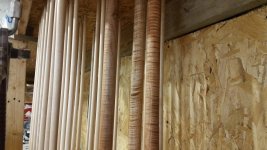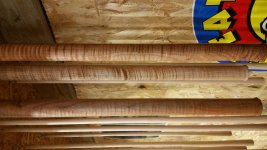Anyone ever use this curly maple?
- Thread starter snipershot
- Start date
They ding easily.
JC
Coos Cues
I was advised by folks way smarter than I not to use this western maple for a cue but I don't listen so well so I plan to anyway. I put an epoxy finish on a piece and it and beat it around and it doesn't seem much more fragile then a lot of other wood I have (walnut burl, camphor burl, koa). I just can't get away from it's looks.
![001 [800x600].JPG 001 [800x600].JPG](https://forums.azbilliards.com/data/attachments/300/300659-1d72d090496a5645c7de5c3205c95b63.jpg?hash=HXLQkElqVk)
I even plan to try some cool old growth knotty douglas fir. This block I have is pretty hard for a "soft wood". I have some rounds of it in a pile with a lot of other woods and many people have had their eye caught by it and asked what it is and think it's nice looking. I guess I just don't want to build the cues every one else is.
![003 [800x600].JPG 003 [800x600].JPG](https://forums.azbilliards.com/data/attachments/300/300660-1da1085291574f79514583a8598ecdd1.jpg?hash=HaEIUpFXT3)
JC
![001 [800x600].JPG 001 [800x600].JPG](https://forums.azbilliards.com/data/attachments/300/300659-1d72d090496a5645c7de5c3205c95b63.jpg?hash=HXLQkElqVk)
I even plan to try some cool old growth knotty douglas fir. This block I have is pretty hard for a "soft wood". I have some rounds of it in a pile with a lot of other woods and many people have had their eye caught by it and asked what it is and think it's nice looking. I guess I just don't want to build the cues every one else is.
![003 [800x600].JPG 003 [800x600].JPG](https://forums.azbilliards.com/data/attachments/300/300660-1da1085291574f79514583a8598ecdd1.jpg?hash=HaEIUpFXT3)
JC
Thats some damn good looking stuff right there!
Joe
Joe
Cue makers have been aware of these woods for decades and don't use them. If you guys are going to insist on using the soft wood in a hardwood application, get it properly impregnated with clear acrylic resin. You can't put on a hard enough finish to make up for the too soft wood and epoxy is definitely not a hard finish.
JC
Coos Cues
Cue makers have been aware of these woods for decades and don't use them. If you guys are going to insist on using the soft wood in a hardwood application, get it properly impregnated with clear acrylic resin. You can't put on a hard enough finish to make up for the too soft wood and epoxy is definitely not a hard finish.
Paul many questions pop to mind. At this point all I have done is cut it up to look at it as it was given to me by a friend. What did you core it with when you tried it? Did you use it as a forearm or handle? A segmented handle? What were your results? Did it warp? Crack? Dent up from normal use? Dent up from rough use? Did the cue play soft? What finish did you use? How did they stand up in your testing? Did you sell the cues?
Thanks,
JC
Janka Hardness ratings of Woods:
Bloodwood: 2900
Purplehheart: 2520
Bocote: 2010
Hard Maple: 1450
Western Big Leaf Maple: 850
Loblolly Pine: 690
Western Red Cedar: 350
Balsa wood: 90
Woods known to be good cue woods are at the top. The all purpose hard maple is right in the middle. Western Big Leaf maple is barely above one of the pines. Where is your cut off point? Everyone has to choose for themselves.
This is just hardness...weight and crushing strength of WBL are inferior to hard maple as well.
IMO, if the wood is curly pay for quality curly hard maple. No reason to use Western Big Leaf unless it is insanely quilted.
Bloodwood: 2900
Purplehheart: 2520
Bocote: 2010
Hard Maple: 1450
Western Big Leaf Maple: 850
Loblolly Pine: 690
Western Red Cedar: 350
Balsa wood: 90
Woods known to be good cue woods are at the top. The all purpose hard maple is right in the middle. Western Big Leaf maple is barely above one of the pines. Where is your cut off point? Everyone has to choose for themselves.
This is just hardness...weight and crushing strength of WBL are inferior to hard maple as well.
IMO, if the wood is curly pay for quality curly hard maple. No reason to use Western Big Leaf unless it is insanely quilted.
JC
Coos Cues
Janka Hardness ratings of Woods:
Bloodwood: 2900
Purplehheart: 2520
Bocote: 2010
Hard Maple: 1450
Western Big Leaf Maple: 850
Loblolly Pine: 690
Western Red Cedar: 350
Balsa wood: 90
Woods known to be good cue woods are at the top. The all purpose hard maple is right in the middle. Western Big Leaf maple is barely above one of the pines. Where is your cut off point? Everyone has to choose for themselves.
This is just hardness...weight and crushing strength of WBL are inferior to hard maple as well.
IMO, if the wood is curly pay for quality curly hard maple. No reason to use Western Big Leaf unless it is insanely quilted.
I never would have gone out and bought that wood but since it was given to me I'm looking at it.
As I said prior, I have already been warned by some of the best minds in the cue building business not to use it. I'm just not 100% convinced the tradeoff's wouldn't be acceptable to the right cue owner. (me?) Cues after all are not designed to take lateral punishment. I have seen even the hardest woods beat up badly. Some folks are harder on stuff than others. Besides I can't make a cue I trust to sell yet anyway so it's a good time to experiment.
JC
My opinion is to build 2 cues with it. 1 piece leave as is but cored with either hard maple or birch. the 2nd one, have it stabilized as stated earlier, and core with the same wood as the 1st one. Play with each cue for awhile and see how the differences are. That way you can determine what is the best route for you and if you decide to make and sell them. Only way to know for sure is to try it and determine for yourself.
Thanks for all the input fellas. Ill make a couple cues with this stuff and if it sucks, ill use it for pen blanks. Lol.
Joe
Joe
Paul many questions pop to mind. At this point all I have done is cut it up to look at it as it was given to me by a friend. What did you core it with when you tried it? Did you use it as a forearm or handle? A segmented handle? What were your results? Did it warp? Crack? Dent up from normal use? Dent up from rough use? Did the cue play soft? What finish did you use? How did they stand up in your testing? Did you sell the cues?
Thanks,
JC
I am not talking about stabilizing the wood, I mean having it impregnated with acrylic resin, tripling the weight, then coring the impregnated (hardened) piece. Big leaf maple is too soft, it soaks up the feel of the hit and the inevitable dents will be DENTS. Warping and cracking are not issues. I've only used impregnated, quilted, big leaf maple for a few handles which were cored with hard maple.
Best hitting cue I've ever owned had a big leaf maple handle. Just my .02 from the non cuemaking peanut gallery.
It was cored with rosewood, I bet.
It was cored with rosewood, I bet.
I'd ask, but the cuemaker is unavailable. If memory serves it wasn't, but no way to verify.


